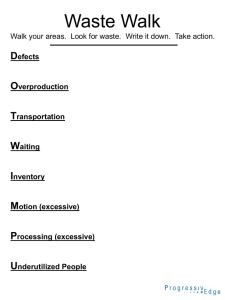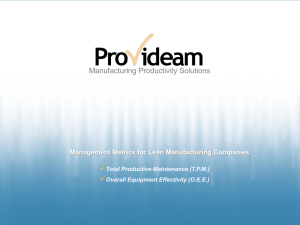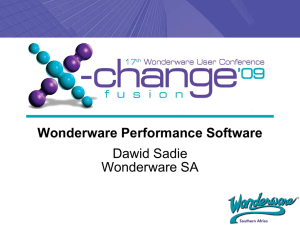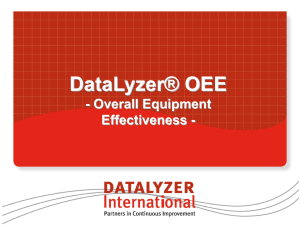slides_3e_chp11
advertisement
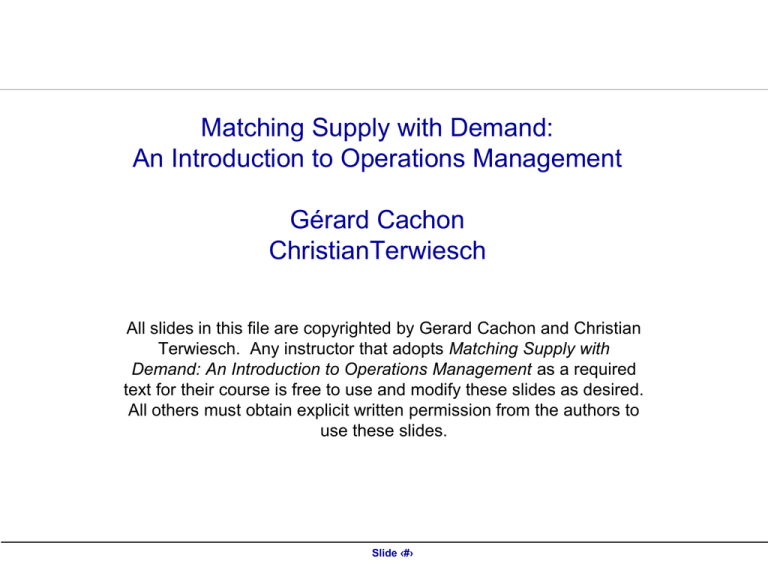
Matching Supply with Demand: An Introduction to Operations Management Gérard Cachon ChristianTerwiesch All slides in this file are copyrighted by Gerard Cachon and Christian Terwiesch. Any instructor that adopts Matching Supply with Demand: An Introduction to Operations Management as a required text for their course is free to use and modify these slides as desired. All others must obtain explicit written permission from the authors to use these slides. Slide ‹#› Lean and Toyota Slide ‹#› Assembly Operations Exercise Slide ‹#› The Role of Labor Costs in Manufacturing: The Auto Industry 100% Other Overhead Warranty Quality 90% 80% 70% Assembly and other Labor costs 60% 50% Purchased parts and assemblies 40% Parts and material costs Logistics costs 30% 20% Material costs 10% 0% Final Assembler’s cost Including Tier 1 Costs Including Tier 2 Costs Rolled-up Costs over ~ 5 Tiers • While labor costs appear small at first, they are important - look relative to value added - role up costs throughout the value chain • Implications - also hunt for pennies (e.g. line balancing) - spread operational excellence through the value chain Slide ‹#› Source: Whitney / DaimlerChrysler Product Requirements Material costs Buzzer Resistor Light Emitting Diode Breadboard Wire Design is specified by this drawing Product must function correctly (test: LED blinks 5 seconds) Aesthetics are welcome, but not considered in the supplier selection Slide ‹#› $1.13 per unit $0.66 per unit $0.23 per unit $5.02 per unit $0.01 per board Process Requirements Cut Wires Mount Wires Mount Components Four step worker paced line must be used Assembly steps have to be performed in the sequence indicated above Workers work 7 hours a day (this is net of breaks) Workers cannot be assigned to multiple steps / rotate between steps, etc One material handler moves parts between stages Overhead costs of $1000 per day Your management expects your plant to generate $1000 per day in profits Slide ‹#› Inspect Assignment 20 1. Measure activity times 2. Do cost calculations 3. Submit a sealed bid to me Slide ‹#› The IMVP Studies General Motors Framingham Assembly Plant Versus Toyota Takaoka Assembly Plant, 1986 GM Framingham Gross Assembly Hours per Car Assembly Defects per 100 Cars Assembly Space per Car Inventories of Parts (average) Toyota Takaoka 40.7 130 8.1 2 weeks 18 45 4.8 2 hours Gross assembly hours per car are calculated by dividing total hours of effort in the plant by the total number of cars produced Defects per car were estimated from the JD Power Initial Quality Survey for 1987 Assembly Space per Car is square feet per vehicle per year, corrected for vehicle size Inventories of Parts are a rough average for major parts Slide ‹#› Lean Tool-box This set of slides summarizes a set of lean operations tools (there is much more): 1. Mapping the Process Flow 2. Identifying sources of wasted capacity 3. Understanding barriers to flow 4. Standardization of work / standard operating procedures 5. Balance resources and have demand drive the process 6. Overall Equipment Effectiveness / Effective Capacity Utilization Slide ‹#› Tool 1: Mapping Out the Process Non-Referrals List of tasks generated: 15 min target Broker fills out forms Customer goes to broker 30 mins Telephone or inperson Sales and marketing disconnected from operations Transfer to ISC • Check app - 55% non-referral - 45% full referral • Call broker and provide list of required docs • Record on electronic notepad • Target 3hr return call for full referral 24 hrs (based on arrival time) from nonreferral Place apps in in-boxes •Sorted •Allocated •Not true FIFO Based on auto UW system •Declaration signed •Direct Debit •Valuation Report •Etc Referrals 20 min target Flags •Shared Ownership •Foreign national •Sale and completion Not simultaneous Application Send Fax No answer •15/20 min target Computer flags automatically Pre-Offer Post-Offer Call for info Review Case 13 min target Lack of a value stream perspective •Request materials •Check for errors Large WIP and long lead times Application complete Make offer Completion of house Broker gets paid Weeks to months Give Up Chase Team •Targets to chase up docs •(3/7/12/18/28 days) Phone duty Call broker if there are document problems Application complete Make offer Widely varying demand Slide ‹#› Broker contacts customer •Add to note pad •Requests required information Phone duty •Check status •Review post •Automatic •Call broken ??? Call Broker to speak directly CPS Team Materials submitted Received via - Nexus - PC fax - Manual fax Redundant work •Review incoming post •24 hr target to review •Automatic •Call broker Variable performance amongst associates Tool 2: Understand Sources of Wasted Capacity Poor use of capacity – Waste of the Resource’s time Overproduction Transportation Rework Over-processing Motion The seven sources of waste (Muda) Potential eighth source of waste: The waste of intellect Inventory Waiting Not “orthogonal to each other” Poor flow – Waste of Customer’s time • The first five sources are RESOURCE centric • You find them by observing / attaching yourself to a resource • Observation and data collection on the front line is key Slide ‹#› MyObserver Tool 3: Understand the Barriers to Flow : The Customer’s Perspective How much time does a patient spend on a primary care encounter? 20 minutes Driving Appt. Parking Check-in Vitals Waiting Check out Labs Drive home PCP Two types of wasted time: Auxiliary activities required to get to value add activities (result o Wait time (result of bottlenecks / insufficient capacity) =>“Produc Inventory: the symptom of poor flow - associated with (a) financing cost Total value Flow Time Efficiency (or %VAT) = add time of a unit unit is in the process Slide ‹#› time Waiting time: opposite side of theTotal same coina(Little’s Law) Tool 4: Standard Operating procedures / Quartile Analysis Activity times by Operator Call durations 2:00 min. Operator KB short KB Operator NN 2:30 min. Operator BJ 3:00 min. NN Operator BK 3:30 min. Operator SD Operator NJ 4:00 min. BJ Operator CT long 4:30 min. BK Low courtesy Best Practice in team High courtesy Courtesy / Friendliness (qualitative information) SD Quartile analysis is an easy tool to identify performance variation NJ in performance often reflects a poor process standardization Variation Slide ‹#› Tool 5: Balance Resources and Have Demand Drive the Process Balance the Line Staff to Demand Look for idle time and measure labor utilization Reduce idle time by: Staffing to demand (potentially eliminating excess process capacity) Balancing the line (reduce idle time created by excess capacity relative to bottleneck) Slide ‹#› Tool 6: Overall equipment effectiveness (OEE) 100 55 Improvement potential > 300% 45 30 Total Brea Chang Avail Idling Re- Net Defe Start- OEE and duce oper cts up plan k- eaned dow overs able minor d n timeSpeed Spee ting Quality losses stop- losses up-Downtime losses X pages d ratetime timeAvailability rate XPerformance Quality rate = (quar OEE 67 % 55 % 82 % Slide ‹#› Total paid time Time in practice Time booked For appointments Time with patients Activities that don’t have to be done by MD Patients that don’t have to see MD Cancelations Time not booked Sick Vacation Tool 6: Overall equipment effectiveness (OEE) True value add time Step 1: start with the “book-ends” (very left and very right bar) Step 2: Include the results from the previous steps - Wasted capacity ‹#› - Customer wait timeSlide (can show up in the form of cancelatio Capital One Case: A Structured Approach Step 1: Map the process and understand the overall process flow (from beginning to end) Step 2: Do we believe there is an improvement Step 3: opportunity here? Tool Map the process Sources of Wasted c Flow Time Efficienc Understand demand What overall (system level) targets exist? What is the status quo relative to this Step 4: target? Staff to demand => Performance gap Quartile Analysis What does the overall target mean for Step 5: each resource? Slide ‹#› What is the current capacity at each OEE Analysis The Toyota Production System – An alternative to traditional mass production Taylorism: Standardized parts and work patterns (time studies) Moving line ensuring working at same pace Process driven huge, 1923 rapid 1903 1908 1911 by 1913 1st car 1st Model F.W. 1st 2.1 T Taylor moving million machinery line vehicles/ Cos 95 with inflexible batch year t production 0 36 US 290 D/u 0 1916 1926 nit 19 04 Mass production driven by economies of scale impossible – Low production volume (1950): GM 3,656,000 – Toyota 1933 1946 1950 1960s 1980s Founded Major strike TransStart of Supplier 11,000 TPS develop- plants ment – Low productivity (Japan 1/9 of US) Key ideaofofresources TPS: – Lack systematic elimination of non-value-adding activities Key idea of Ford: cost reduction through Source: McKinsey Slide ‹#› cheap labor and economies Toyota Production System: An Overview Zero non-value added activities (muda) 8.2 Zero defects, zero breakdowns, zero inventory, zero set-up Production flow synchronized with demand (JIT) One-unit-at-a-time flow Mixed model production (heijunka) Piece-by-piece transfer (ikko-nagashi) Match production demand based on Takt time Pull instead of push Supermarket / Kanban Make-to-order 8.4 Quality methods to reduce defects Fool-proofing (poka-yoke) and visual feed-back Detect-stop-alert (Jidoka) 8.5 Defects at machines (original Jidoka) Defects in assembly (Andon cord) Build-in-quality (tsukurikomi) Reduce inventory to expose defects 8.6 Flexibility Standardization of work Worker involvement Adjustment of capacity to meet takt-time Multi-task assignment (takotei-mochi) 8.7 Reduction of Variability Quartile Analysis Standard operating procedures 8.8 Quality circles (Kaizen) Fishbone diagrams (Ishikawa) Skill development / X-training 8.9 More details on the Toyota Production System: See chapter in 2nd edition “Matching Supply with Demand” Slide ‹#› Assume a 1 minute takt time 7 8 5 4 6 3 1 2 ITAT=7*1 minute 4 1 3 2 ITAT=2*1 minute Inventory in process The Impact of Inventory on Quality Defective unit Good unit Buffer argume “Increase inve Toyota argume “Decrease inve Zero inventory is a really bad idea … Inventory leads to a longer ITAT (Information turnaround time) => slo Inventory takes pressure off theSlide resources (they feel buffered): demons ‹#› Just-in Time Process Reduces Inventory and Drives Quality Pull: Synchronized production Pull: Kanban Authorize production of next unit • Part produced for specific order (at supplier) • shipped right to assembly • real-time synchronization • for large parts (seat) • inspected at source • Visual way to implement a pull system • Amount of WIP is determined by number of cards • Kanban = Sign board • Work needs to be authorized by demand Slide ‹#›




